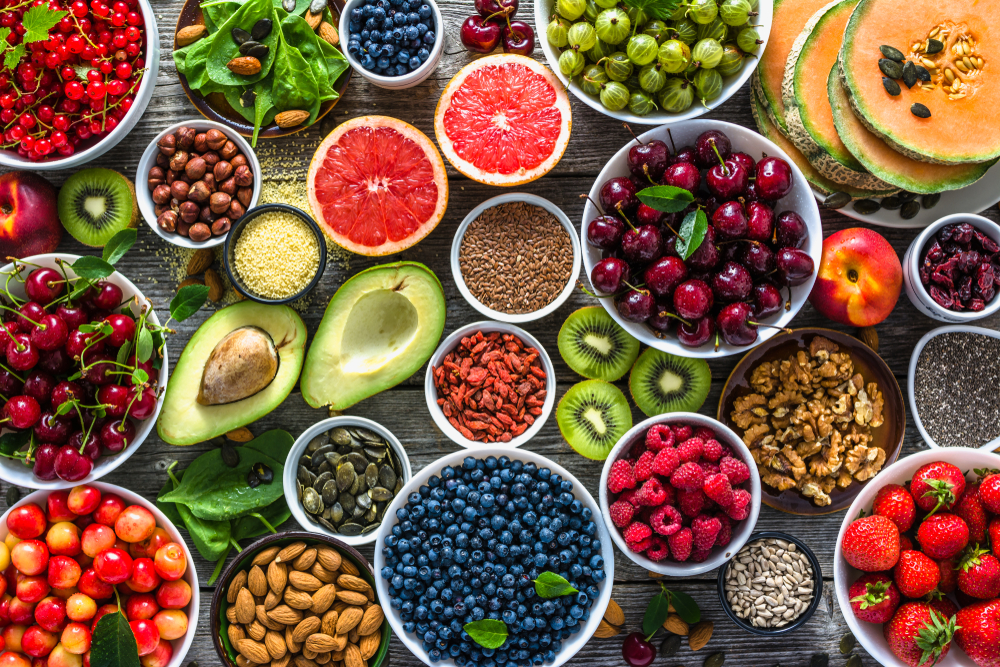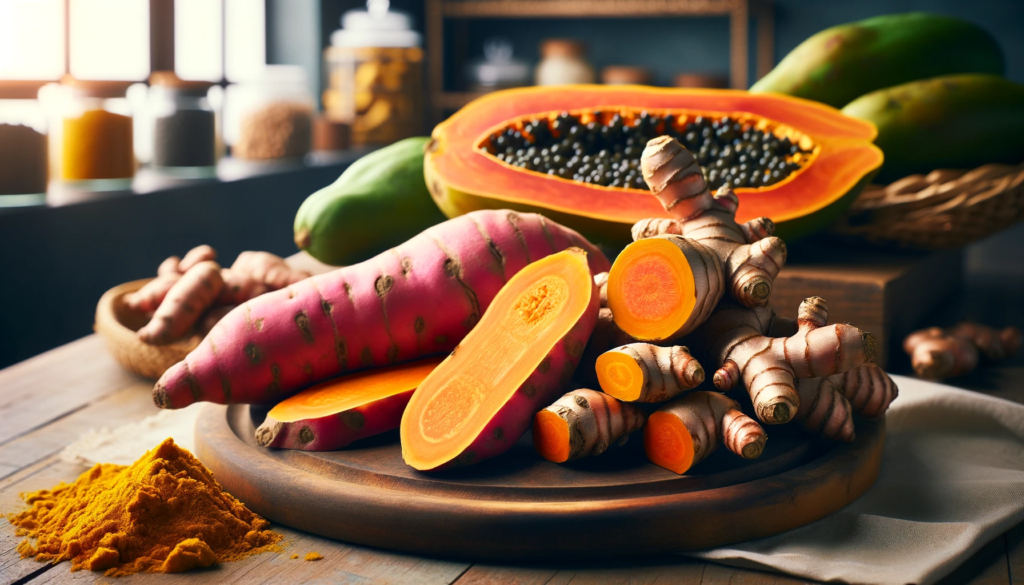Introduction to Oceania’s Superfoods
Exploring the Nutritional Gems of the Pacific Islands
The Pacific Islands, a tapestry of vibrant cultures and lush landscapes, are also home to an array of superfoods. Rich in nutrients and often packed with medicinal properties, these foods have sustained and nourished generations of islanders. They encapsulate the life-giving force of the land and sea, promising health benefits that modern science is just beginning to uncover. From the healing powers of Noni fruit to life-sustaining staples like breadfruit and taro, Oceania’s culinary heritage presents a treasure trove of natural ingredients that promote wellness and vitality. As we dive into the delicious world of these nutritionally dense superfoods, we invite you to discover how each can contribute to a healthier lifestyle while offering a taste of the exotic.
1. Noni (Morinda citrifolia) – The Polynesian Health Booster
Health Benefits and Ways to Enjoy Noni
Long cherished in Polynesian culture as a cure-all, Noni, or Morinda citrifolia, has a storied history of therapeutic use. This pungent fruit may not win any beauty contests, but its health benefits are widely praised. Packed with antioxidants, anti-inflammatory agents, and immune-boosting compounds, Noni supports general well-being and has been studied for its potential in combating chronic diseases. Though its taste is an acquired one, Noni can be consumed as a juice, often mixed with other fruit extracts to soften its bold flavor. You can also find it as a supplement but enjoying it in a more natural form offers a traditional experience that connects you to the essence of Pacific Islander health practices.
2. Kava (Piper methysticum) – A Relaxing Root Beverage
Therapeutic Uses and Preparation of Kava
Kava, derived from the root of the Piper methysticum plant, is more than just a beverage in Oceania—it’s a cultural touchstone. Revered for its calming effects, Kava is central to many Pacific societies’ communal rites and social gatherings. It is known for its sedative properties, aiding stress relief and relaxation without affecting mental clarity. To prepare Kava, the root is traditionally ground into a powder and infused with water, resulting in a muddy, earthy tonic. Modern incarnations include convenient tea bags and supplements, though for a truly authentic experience, participating in a Kava ceremony is a must for understanding its cultural and therapeutic significance.
3. Breadfruit – A Versatile and Nutrient-Rich Staple
Nutritional Profile and Culinary Uses of Breadfruit
Breadfruit is a multipurpose tree crop that has provided sustenance in the Pacific for centuries. It’s highly versatile—eaten ripe as a fruit or, when unripe, used as a potato-like vegetable. Its soft, creamy flesh is not only delectable but is also a powerhouse of nutrients, packed with fiber, vitamins, and minerals. Breadfruit can be roasted, baked, fried, or boiled, making it a perfect substitute for other starchy carbohydrates. Beyond its culinary flexibility, breadfruit trees serve ecological benefits like improving soil health and contributing to sustainable agricultural systems, making this tropical staple a superfood in more ways than one.

4. Taro Root – The Heart of Pacific Island Diets
Health Benefits and Recipe Ideas for Taro
Taro root, with its purple-tinged flesh, lies at the core of Pacific Island diets and carries significant historical importance. This starchy tuber is celebrated for its superior nutritional profile, featuring high levels of fiber, vitamins C and E, and antioxidants. It serves as a digestive aid, supports immune function, and possesses anti-diabetic qualities. Taro can be transformed into an array of dishes, from the simple boiled root to the more complex fermented delicacy known as poi. Ground into flour, it becomes an ingredient for gluten-free baking, showcasing taro’s adaptability and resilience as a food source.
5. Kumara (Sweet Potato) – A Rich Source of Vitamins
The Versatility and Health Advantages of Kumara
Kumara, or sweet potato, is an endearing superfood with deep roots in the culinary traditions of Oceanic cultures. Loaded with beta-carotene, which the body converts into vitamin A, this naturally sweet tuber also boasts high levels of vitamins C and B, dietary fiber, and essential minerals. Kumara’s health benefits include promoting eye health, enhancing immunity, and stabilizing blood sugar levels. From a culinary perspective, kumara is infinitely adaptable, lending itself to both savory dishes, such as stews and baked preparations, and sweet treats like pies and puddings. Its inherent sweetness can even reduce the need for added sugars, echoing modern nutrition principles.
6. Fijian Turmeric – A Potent Anti-Inflammatory Spice
Medicinal Properties and Culinary Applications of Fijian Turmeric
Fijian turmeric stands out with its vibrant color and potent health-promoting properties. This golden-hued spice isn’t just a culinary adornment but is also recognized for its anti-inflammatory and antioxidant benefits. The active compound, curcumin, is linked to the reduction of inflammation-related ailments and may assist in managing oxidative stress. In the kitchen, Fijian turmeric adds a warm, earthy essence to curries, marinades, and beverages. A pinch of turmeric can transform a simple dish into a tapestry of flavor and health, symbolizing the confluence of traditional healing and modern dietary desires.
7. Papaya – A Tropical Fruit Loaded with Nutrients
Health Benefits and Delicious Ways to Eat Papaya
Papaya is not only a sweet treat favored in tropical regions, but it’s also a vitamin C titan, delivering a wealth of antioxidants, digestive enzymes (papain), and other essential nutrients like folate and potassium. Due to its nutrient composition, eating papaya may benefit skin health, digestion, and even cardiovascular health. This juicy delight can be eaten fresh, added to fruit salads, or blended into smoothies. In its green form, papaya serves as a vegetable in salads and stir-fries. Don’t overlook the seeds—they are edible, too, known for their peppery flavor and potential health properties.

8. Niu (Coconut) – The Multipurpose Tropical Food
Nutritional Benefits and Uses of Various Coconut Products
Coconut, or Niu, revered in many tropical cultures, is truly a superfood with its multifaceted uses and health benefits. The water, milk, oil, and flesh from the coconut each provide unique nutritional advantages, like hydration, healthy fatty acids, and minerals essential for bodily function. As a food source, coconut’s versatility is unparalleled; it’s used in desserts, soups, and main dishes, contributing rich flavor and creamy texture. Coconut oil also finds use outside the kitchen as a skin and hair care product, reflecting its broad impact on health and lifestyle. Embracing products from the coconut palm is an excellent way to equalize pleasure and nutrition.
9. Manuka Honey – New Zealand’s Healing Nectar
Unique Properties and Health Applications of Manuka Honey
New Zealand’s Manuka honey is a rare gem, renowned worldwide for its unique healing properties. The honey is produced by bees that pollinate the Manuka bush, resulting in a product that contains Methylglyoxal (MGO), a compound with potent antibacterial properties. Manuka honey is a sweet indulgence, ally against infections, and a booster for overall well-being. It can soothe sore throats, aid digestion, and even topically for skin care applications. As a natural sweetener with added health benefits, Manuka honey is an exquisite example of how nature’s bounty provides both flavor and functional nourishment.
10. Tasmanian Pepperberry – A Flavorful Antioxidant Powerhouse
Culinary Uses and Health Benefits of Tasmanian Pepperberry
The Tasmanian Pepperberry, a wild shrub native to southeastern Australia’s woodlands and cool rainforests, is gaining recognition as a culinary spice and antioxidant powerhouse. It contains polyphenolic compounds that combat oxidative stress and may reduce inflammation. Its intense peppery flavor, with undertones of berries, makes it a unique addition to seasonings and sauces. Beyond the kitchen, it is also used in immune-boosting herbal teas. As this spice starts to step onto the global stage, it offers a taste of Tasmania’s wild landscapes and a testament to the health-giving qualities of indigenous plants.
Incorporating Oceania Superfoods into Your Diet
Tips and Recipes for a Nutrient-Rich Diet
Embracing Oceania’s superfoods can lead to a diet rich in nutrients, flavors, and cultural significance. Integrating these foods into your meals is easier than it may seem. Start by substituting common ingredients with their Oceanic counterparts—replace potato with breadfruit or taro, enhance your dishes with a sprinkle of turmeric, and reimagine desserts with sweet kumara. Papaya and coconut products make for excellent snacks and ingredients in smoothies. Trying native recipes can also deepen your appreciation and deliver a more authentic consumption experience. By incorporating Oceania’s superfoods, you’re not just nourishing your body but exploring a culinary adventure that bridges tradition and wellness.
The Health Impact of Traditional Oceanian Foods
Understanding the Role of Native Foods in Wellness
The traditional foods of Oceania are more than mere sustenance; they represent a connection to land, culture, and ancestors. These foods have evolved to offer optimal nutrition in their native environments, where the natural elements shape their growth and potency. The inclusion of these native foods in modern diets offers lessons in both simplicity and nutrition. They’re typically less processed, closer to their natural state, and therefore retain a higher nutritional content. By embracing the principles of traditional Oceanian diets, we can benefit from a profound spectrum of health impacts, aligning historical wisdom with contemporary understanding of diet and health.
FAQs on Oceania’s Superfoods
What Are the Health Benefits of Noni Fruit?
Noni fruit is celebrated for its wide-ranging health benefits, many of which have been embraced in traditional Polynesian medicine for centuries. The fruit is a rich source of antioxidants and has been associated with various healthful properties, including anti-inflammatory and immune-boosting effects. It’s also noted for its potential in aiding digestion, improving skin quality, and even showing promise in research looking at cancer prevention. Understanding the full spectrum of Noni’s benefits, however, necessitates further scientific study to complement anecdotal and traditional usage.
How Can I Prepare and Cook Breadfruit?
Breadfruit can be prepared in myriad ways, similar to other starchy staples like potatoes. At its simplest, breadfruit can be roasted or boiled. To roast, cut the fruit into quarters and bake until the flesh is soft and the skin is browned. Boiled breadfruit is peeled, diced, and cooked in water until tender. It can also be used in soups, stews, and even desserts. Breadfruit’s versatility makes it a culinary canvas for an array of dishes, making it a fitting addition to any meal seeking a touch of tropical flair.
Is Kava Safe for Regular Consumption?
Kava has a long history of use in many Pacific Island societies for its sedative and calming effects. While it’s generally considered safe when consumed traditionally (as a water-based infusion), it’s crucial to adhere to moderate use due to potential effects on the liver with excessive consumption. Kava should be used judiciously, and those with pre-existing liver conditions or taking medications that affect the liver should consult a healthcare professional before consumption. As with any supplement or food with medicinal properties, responsible use is key to its safe inclusion in a diet.
What Makes Manuka Honey Different from Regular Honey?
Manuka honey stands out from regular honey due to its potent antibacterial properties stemming from the presence of Methylglyoxal (MGO). This compound arises from the conversion of another compound, dihydroxyacetone, that is particularly concentrated in the nectar of Manuka flowers. Manuka honey’s antibacterial efficacy is often rated by a Unique Manuka Factor (UMF), a measure of its quality and strength. Additionally, this honey offers anti-inflammatory and antioxidant benefits, making it an exceptional variety among honeys for health-focused consumers.
Can Taro Root Aid in Dietary Health?
Yes, taro root can contribute positively to dietary health. It’s an excellent source of fiber, which is beneficial for digestive health and can help maintain a healthy gut. It’s also packed with resistant starch, which doesn’t raise blood sugar levels as rapidly as other starches, making it a potentially good choice for individuals managing diabetes. Moreover, taro offers a good dose of vitamins and minerals, such as vitamin E, vitamin C, and potassium, contributing to overall well-being when included as part of a balanced diet.
